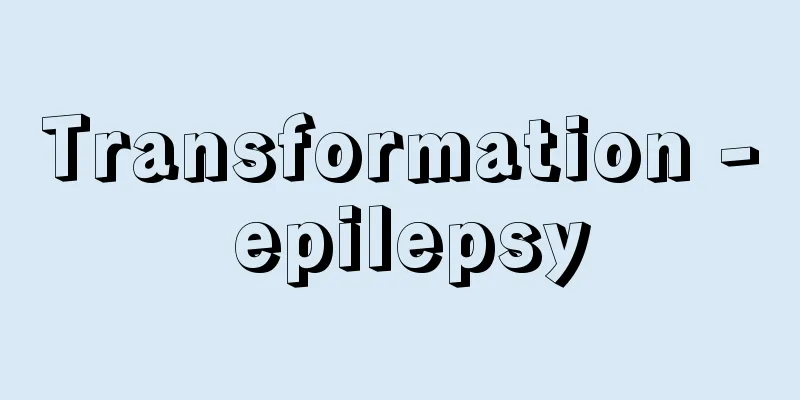Transformation - epilepsy

|
A phenomenon in which deoxyribonucleic acid (DNA), a type of nucleic acid extracted from cells of one lineage of an organism, is introduced into living cells of another lineage, causing the DNA to be incorporated into the cells and change their genetic characteristics. This phenomenon was first discovered in 1928, when British researcher F. Griffith conducted experiments using pneumonia bacteria. Griffith heated and killed pathogenic pneumonia bacteria cells (called S-type bacteria), which have a thick polysaccharide membrane (capsule), and then mixed them with mutant cells of the same bacteria that have no capsule and are non-pathogenic (called R-type bacteria). He then injected the mixture into mice, causing the mice to fall ill and die, and found that the S-type bacteria that should have died from the heat appeared in the corpses. Later, three Americans, Avery, C. M. MacLeod, and M. McCarty, studied which components of the S bacteria killed by heat in Griffith's experiment were capable of transforming R cells into S cells, and in 1944 they discovered the phenomenon of transformation, in which when DNA was chemically extracted from dead S bacteria and added to living R cells, the R bacteria were transformed into S cells. This experiment is significant because it showed that the genes that determine the genetic traits of pneumonia bacteria, S type or R type, are DNA, and it was the first time that the main body of genes was DNA. For transformation to occur, the genetic DNA must be extracted without damage, taken up by the recipient living cell without being decomposed, and undergo genetic recombination with the chromosomal site homologous to the gene within the cell. Transformation experiments have been reported to be successful with bacteria such as Escherichia coli and Bacillus subtilis, as well as several species of eukaryotes, such as yeast, Drosophila melanogaster, and petunia, in addition to pneumonia bacteria, but there have been many unsuccessful experiments. Recently, in genetic engineering experiments, it has become possible to take recombinant DNA made by combining eukaryotic genes with plasmids, a gene carrier that replicates autonomously within cells, into living cells such as Escherichia coli and express genetic traits. It is known that transformation experiments are successful when recombinant DNA is grown together with host cells such as Escherichia coli and a large number of genes are collected to perform transformation experiments. [Tatsuo Ishikawa] Source: Shogakukan Encyclopedia Nipponica About Encyclopedia Nipponica Information | Legend |
|
生物のある系統の細胞から抽出された核酸の一種であるデオキシリボ核酸(DNA)を、ほかの系統の生きた細胞に与えたとき、DNAがその細胞に取り込まれて遺伝形質が変化する現象。この現象は、1928年イギリスのグリフィスF. Griffithが肺炎菌を用いて行った実験が端緒となり発見された。グリフィスは、肺炎菌のなかで多糖類からなる厚い膜(莢膜(きょうまく))をもち病原性のある細胞(S型菌とよぶ)を熱して殺したのち、同種の菌の突然変異体で莢膜をもたず病原性のない細胞(R型菌とよぶ)と混ぜてネズミに注射したところ、ネズミは発病して死に、死体には熱で死んだはずのS型菌が出現することをみいだした。その後、アメリカのエーブリー、マクレオドC. M. MacLeod、マッカーティーM. McCartyの3人は、グリフィスの実験で熱により死んだS型菌のどの成分がR型細胞をS型に変える働きをもつかを研究し、1944年に、死んだS型菌から化学的にDNAを抽出してR型の生細胞に加えるとR型菌がS型に変化するという形質転換現象をみいだした。 この実験は、S型かR型かという肺炎菌の遺伝形質を決定するもの、すなわち遺伝子がDNAであることを示し、遺伝子の本体がDNAであることを初めて証明したものとして大きな意義をもっている。形質転換がおこるためには、遺伝子DNAが損傷なしに抽出され、受入れ側の生きた細胞に分解されずに取り込まれ、細胞内でその遺伝子と相同な染色体部位と遺伝的組換えをおこさなくてはならない。形質転換実験は肺炎菌のほか、大腸菌や枯草菌など細菌類、酵母、ショウジョウバエ、ペチュニアなど真核生物のいくつかの種で成功したと報告されているが、不成功に終わった実験例も多い。最近、遺伝子工学実験においては、真核生物の遺伝子と細胞内で自律増殖する遺伝子の運び手、プラスミドを結合してつくった組換えDNAを大腸菌などの生細胞に取り込ませ遺伝的形質を発現させることができるようになった。組換えDNAを大腸菌など宿主細胞とともに増殖させ、多数の遺伝子を集めて形質転換実験を行うと成功することが知られている。 [石川辰夫] 出典 小学館 日本大百科全書(ニッポニカ)日本大百科全書(ニッポニカ)について 情報 | 凡例 |
<<: Transduction - transduction
Recommend
Sekishu-banshi paper
Washi paper produced in Misumi-cho, Hamada City, a...
Kamiyamada [town] - Kamiyamada
A former town in Sarashina County in the Chikuma R...
Joachim
German violinist, conductor, and composer. One of ...
Grain Ban Incident
This was a dispute between Japan and Korea over t...
Scale foil - Urokohaku
…The color of the fabric changes depending on the...
Kirimine Shrine
…Because it borders Iwakuni City and Yanai City, ...
Eduard Georgievich Bagritskiy
Soviet poet. His real name was Dzyubin. He was bo...
Legal Times - Law Times
Modelled on the German Juristen Zeitung, this is J...
Centrifuge (art) - entanglement
...In Russian, it is called futurizm. Four main g...
Board scraps - Itakasu
...In the Edo period, the technology for making s...
advaitavāda (English spelling)
...In Sanskrit, it is called Advaita. The philoso...
Araki Construction - Araki Koji
...Even in areas where wood was scarce and people...
Kagamizuka Tomb
This keyhole-shaped tumulus is located in Kusaka-g...
Rainbow gnome (English name) Elagatis bipinnulatus
A marine fish of the family Carangidae in the orde...
McCune-Albright syndrome
…Of these, brain tumors, especially pineal tumors...









